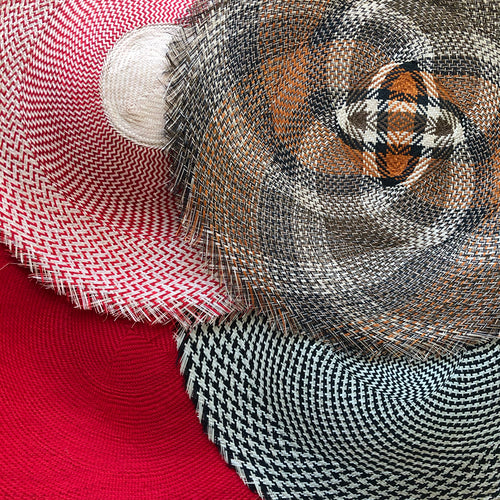
All About Buntal
Share

At first glance they look like placemats for your kitchen table. Natural fibres, hand woven and hand dyed buntal mats appeal to many milliners who appreciate the craftsmanship of individually made quality products. As such, buntal mats are continuing to grow in popularity as a hat making material.
Here is the process of how the buntal fibre goes from tree to titfer*.
You may also be interested in our blog post, which highlights milliners around the world who have taken buntal mats from Flat to Fabulous.




The strong buntal fibre is naturally plyable and the weave easily takes a shape over a block or can be used free form.
The natural colour of the buntal fibre when dried is an ivory/cream,which is referred to as white. Here is the simply elegant buntal mat.

What is Buntal? Buntal is a fine Philippine fibre from the stalks of the unopened leaves of the Corypha (Genus), Talipot or Buri** Palm.
The fibres are dried, then dyed and hand woven into mats, which we use for hat making.

The Corypha palm frond (leaf) is fan shaped the leaflets (segments) extending from a central point at the end of the frond stalk called a petiole.

The petiole is beaten until the fibres separate.
The fibres are drawn out of the petiole by hand.

Laid to dry they become a lovely warm white.
The buntal "natural" is much lighter than the “natural” colour of straw, which sometime leads to confusion which is comes to colour names. Natural white is a not an optical white.
The dried fibres are smashed again to soften the strands for weaving.

Solid colour mats are woven as white and then dyed.
Swirl and checkerboard patterns require the fibres to be dyed first then woven.
In preparation for weaving the fibres are counted, then organised.


Weaving begins with the centre called the button

Colours highlight the woven patterns.

There is variety of patterns including solid, checkerboard, and swirls.
The checkerboard and swirl can come with a white center.
As a natural product, each fibre takes colour differently which contributes to the beauty by adding depth of colour to the overall mat.
As is the case with anything handmade, there will always be variation in the weaving as well. It is part of the charm and to be embraced. The swirl mats have many colours with major and minor colours themes and occassionally an unexpected twist of additional colour on the whim of the weaver.
How to use Buntal Mats
To work with this material, spritz with water to dampen the fibres, it does not need to be soaked. If using it on a block, place your centre point and smooth the mat over the block.
Use a cord, ribbon or reed to secure the base of the crown before shaping the brim.

To smooth any wrinkles or bubbles from the mat, move the fibres in the direction of the weave, a curving motion around the block.
Once the hat dries, brush on a straw stiffener or diluted PVA to hold the shape and again let it dry.
Another creative choice is a hand shaped buntal mat headpiece.
Take a look at a collection of milliners from around the world who have made stunning hats with B Unique Buntal Mats in Flat to Fabulous.
** There is another type of palm called a Buri from Brazil, it is a different tree.
